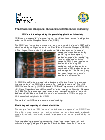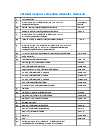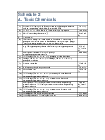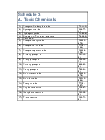Chemical Weapons Convention guidance
Guidance for those producing, processing, consuming, importing or exporting chemicals covered by the Chemical Weapons Convention (CWC)
The Chemical Weapons Convention
The UK is one of 192 countries that have ratified the Chemical Weapons Convention (CWC), the first arms-control treaty to introduce a verifiable ban on an entire class of weapons of mass destruction.
The CWC entered into force on 29 April 1997 and all Member States must agree to its provisions, which include:
- to chemically disarm by destroying all stockpiles of chemical weapons, any facilities which produced them and any old or abandoned chemical weapons from the past
- never to develop, produce, stockpile or use chemical weapons
- submit regular declarations to the Organisation for the Prohibition of Chemical Weapons (OPCW) on the production, processing, consumption, and import and export of certain dual-use chemicals
- allow the OPCW to carry out routine inspections on their territories
The OPCW is based in The Hague, and has the mandate to achieve the object and purpose of the CWC, which includes an international verification regime to build confidence between CWC States Parties.
UK CWC National Authority
The CWC UK National Authority (UKNA) is based in the Department for Business, Energy and Industrial Strategy (BEIS) and is responsible for implementing the CWC throughout the UK, the Crown Dependencies and the Overseas Territories. Our powers to do this are contained in the Chemical Weapons Act 1996. The Act outlines the legal obligations on those producing, processing, consuming, importing or exporting certain toxic chemicals. The UKNA also takes part in efforts, led by the Foreign and Commonwealth Office (FCO), to strengthen the Biological and Toxin Weapons Convention (BTWC) and is represented in the Counter Proliferation and Arms Control Centre (CPACC).
As part of BEIS’s role to safeguard and promote the peaceful use of chemicals, the CWC UK National Authority:
- compiles annual declarations on UK chemical activity for the OPCW
- facilitates inspections between declared UK sites and the OPCW
- enforces the export and import licensing regulations, in co-operation with the Export Control Organisation
CWC legislation
- The Chemical Weapons Act 1996
- The Chemical Weapons (Overseas Territories) Order 2005
- The Organisation for the Prohibition of Chemical Weapons (Immunities and Privileges) Order 2001
- The Chemical Weapons Act 1996 (Commencement) Order 1996 (S.I. 1996/2054)
- The Chemical Weapons (Notification) Regulations 1996 (S.I.1996/2503)
- The Chemical Weapons (Notification) (Amendment) Regulations 2004
- The Chemical Weapons (Licence Appeal Provisions) Order 1996 (S.I.1996/3030)*
- The Chemical Weapons (Licence Appeal Provisions) (Revocation) (No. 2) Order 2013
- Isle of Man (S.I.1998/2794)
- Guernsey (S.I.2000/0743)
- Jersey (S.I.1998/2565)
- Anti-terrorism, Crime and Security Act 2001
- Export Control Act 2002 – chapter 28
Classification of chemicals
Certain toxic chemicals and their precursors are subject to legal requirements under the CWC. There are 3 classifications of chemicals:
- Schedule 1
- Schedule 2
- Schedule 3
If you produce, process, consume, import or export any of these chemicals you must meet the legal requirements. A full list of scheduled chemicals and their precursors are listed in the 3 attachments below and can also be found on the OPCW website.
The CWC also places legal requirements on unscheduled discrete organic chemicals (DOCs).
Schedule 1 chemicals
Schedule 1 chemicals are particularly hazardous and pose a high risk. They have been developed, produced, stockpiled and used as chemical weapons and have little or no use for activities not prohibited by the CWC.
Use of Schedule 1 chemicals is restricted to pharmaceutical, research, medical and protective purposes related to the protection against toxic chemicals. The CWC places a limit on the aggregated annual amount of Schedule 1 chemicals that each CWC State Party may produce:
- production for research, medical, pharmaceutical or protective purposes must be carried out at a single small scale facility (SSSF) that is approved by the State Party
- production in aggregate quantities not exceeding 10kg per year may be carried out for protective purposes at one facility outside of the SSSF that is approved by the State Party
- production in quantities of more than 100g per year for research, medical or pharmaceutical purposes may be carried out at facilities outside of a SSSF that are approved by a State Party. The aggregate quantity of production must not exceed 10kg per facility
- synthesis of Schedule 1 chemicals for research, medical or pharmaceutical purposes, but not for protective purposes, may be carried out at laboratories in aggregate quantities of less than 100g per facility
- the total national aggregate amount of Schedule 1 chemicals that are produced at any given time must be equal to or less than one tonne
- Schedule 1 chemicals may only be transferred to other CWC States Parties, and only for research, medical, pharmaceutical, or protective purposes. Any chemicals transferred cannot then be transferred to a third State Party
If you produce, use, import or export Schedule 1 chemicals you must be covered by a licence. With the exception of Export licences, all are granted by the CWC UK National Authority.
Schedule 1 chemicals – UK licensing regime
The UK’s Schedule 1 licensing regime includes chemicals that are not specifically listed in Schedule 1 under a particular CAS number but share a chemical structure with the ones that are. This approach reflects technical and legal advice and takes account of the results of consultation exercises with stakeholders.
It is fundamental to the aims of the CWC and the Schedule 1 licensing regime that chemicals which can be or have been weaponised should fall within its scope, in order to enable the UKNA to effectively control the possession and use of such chemicals in the UK. We also want to ensure that our licensing system is applied in a technically consistent way, so chemicals with the same structures, names and toxic properties as chemicals explicitly listed in Schedule 1 are licensable, even if they have different CAS numbers. The UK considers the molecular structure of a chemical in order to determine whether it is covered by Schedule 1 and therefore isotopically labelled analogues, stereoisomers (both optical and geometric), and corresponding salts are licensable.
Due to its relevance and toxicity ricin A chain is licensable.
The table below sets out the additional licensable groups of chemicals under Schedule 1.
| Schedule | Isotopically labelled analogues | Corresponding salts | Stereoisomers |
|---|---|---|---|
| 1A01 | x | x | |
| 1A02 | x | x | |
| 1A03 | x | Explicitly included | x |
| 1A04 | x | ||
| 1A05 | x | x | |
| 1A06 | x | x | |
| 1A07 | x | x | x |
| 1A08 (including ricin A chain) | x | ||
| 1A13 | x | Explicitly included | x |
| 1A14 | x | Explicitly included | x |
| 1A15 | x | x | x |
| 1A16 | x | x | x |
| 1B09 | x | ||
| 1B10 | x | Explicitly included | |
| 1B11 | x | x | |
| 1B12 | x | x |
In order to avoid over-burdensome and unnecessary licensing, to ensure human safety and to support medical research, we have implemented some limited exemptions. These are necessary in order to avoid impeding the legitimate transfer, possession and / or use of, for example, paralytic shellfish poisoning diagnostic kits and some cancer treatments which contain very small amounts of particular versions of Schedule 1 chemicals, as well as contaminated items such as clothing and environmental samples which might contain traces of Schedule 1 chemicals. The exemptions are set out in this document: .
It is a breach of the Chemical Weapons Act 1996 to acquire, produce, possess or use a CWC Schedule 1 chemical without an appropriate licence issued by the UK National Authority.
If you are in any doubt as to whether your activities require a CWC Schedule 1 licence please contact the UK National Authority immediately for further guidance and advice.
This guidance and the exemptions will be kept under review and may be subject to change in the future.
Different licences
Individual Licence to Possess and Use a Schedule 1 Chemical
An Individual Licence to Possess and Use a Schedule 1 Chemical is required for the possession and use of any Schedule 1 chemical for pharmaceutical, medical, research or protective purposes.
As part of the licence application you must give details of the Schedule 1 chemical to be held and used including CAS number, reason for possession and use, quantity to be possessed and used, the location where it will be held and/or used, the supplier and contact details.
All licence applications will be checked to ensure that the chemical type and quantity is consistent with its proposed purpose. The CWC UK National Authority may need to approve the facility where the chemical will be held and used before a licence can be granted.
When a licence is issued it will state the maximum amount of Schedule 1 chemical that can be held at any one time at the specified location during a given period, and the purpose for which it is being held. As part of the licence requirements once granted, you must maintain records regarding the possession and use of the chemical specified on the licence which will be subject to inspection by the CWC UK National Authority. A copy of the records must also be sent to the National Authority within 14 days of the expiry of the licence.
A licence can be granted to possess and use multiple Schedule 1 chemicals.
Individual Licence to Produce, Possess and Use a Schedule 1 Chemical
An Individual Licence to Produce, Possess and Use a Schedule 1 Chemical is required for the production of any Schedule 1 chemical for pharmaceutical, medical, research or protective purposes.
As part of the licence application you must give details of the Schedule 1 chemical to be produced, held and used including the CAS number, reason for production, possession and use, quantity to be produced, possessed and used and the location where it will be produced, held and used.
All licence applications will be checked to ensure that the chemical type and quantity is consistent with its proposed purpose. The CWC UK National Authority may need to approve the facility where the chemical will be produced, held and used before a licence can be granted.
When a licence is issued it will state the maximum amount of Schedule 1 chemical that can be produced and held at any one time at the specified location during a given period, and the purpose of the production and for which it is being held. As part of the licence requirements once granted, you must maintain records regarding the production and use of the chemical specified on the licence which will be subject to inspection by the CWC UK National Authority. A copy of the records must also be sent to the National Authority within 14 days of the expiry of the licence.
A licence can be granted to produce, possess and use multiple Schedule 1 chemicals.
Importing and exporting Schedule 1 chemicals
The importation and exportation of Schedule 1 chemicals into and out of the UK from CWC States Parties must:
- only be for research, medical, pharmaceutical, or protective purposes; and of the types and quantities strictly limited to those which can be justified for such purposes; and
- not be retransferred to a third State.
Schedule 1 chemicals are prohibited from being imported and exported to and from the UK by any CWC Non States Parties.
Any person wishing to import or export CWC Schedule 1 chemicals must ensure either they, or the possessor of the chemicals (if it is to be exported directly from another entity), holds a relevant CWC Schedule 1 chemicals possession licence issued by the CWC UK National Authority.
If you plan to import Schedule 1 chemicals you will need to apply for an import license at least 60 days in advance or the proposed shipment date. This time enables the UK National Authority to liaise with the exporting State party and inform the OPCW 30 days in advance as required before the license can be issued.
The CWC UK National Authority must also be informed of the intended export, from the UK, of any CWC Schedule 1 chemicals at least 60 days in advance of the proposed date of shipment.
IMPORTANT NOTE: Saxitoxin medical/diagnostic notification allowance
The export of the CWC Schedule 1 chemical saxitoxin, in quantities of 5 milligrams or less and only for medical/diagnostic purposes, must be reported to the CWC UK National Authority, at least 1 working day in advance of the proposed date of shipment.
Import and export licence requirements
Anyone contemplating importing or exporting CWC Schedule 1 chemicals into and from the UK should first contact the UK National Authority for advice.
Import licence applications must be submitted to the CWC UK National Authority.
Export licence applications must be submitted to the Export Control Organisation (ECO) in the Department for International Trade for all intended exports of CWC Schedule 1, 2 or 3 chemicals, including Schedule 2 and Schedule 3 chemicals in mixtures, at low concentrations, intended for States Not Party. For information on this process, see the Export Control Organisation web pages.
Import and export obligations for Schedule 2 and Schedule 3 chemicals
There are no restrictions on the importation or exportation of Schedule 2 or 3 chemicals either to or from CWC States Parties. Schedule 2 chemicals are prohibited from being imported and exported to and from the UK by CWC Non States Parties.
Chemical mixtures containing low concentrations of Schedule 2 chemicals can be imported and exported to and from CWC Non State Parties where they are:
- goods or chemical mixtures which contain 1% or less by weight of a Schedule 2A or 2A* chemical
- goods or chemical mixtures which contain 10% or less by weight of a Schedule 2B chemical
- consumer goods packaged for retail sale for personal or individual use
If you export any Schedule 3 Chemicals from the UK to a CWC Non State Party you must receive an End-user certificate (EUC) form stating in relation to the transferred chemicals(s):
- that they will only be used for purposes not prohibited under the Chemical Weapons Convention
- that they will not be re-transferred
- their types and quantities
- their end-use(s); and
- the name(s) and address(es) of the end-user(s)
The certificate must be issued by a competent government department / ministry within the recipient country.
The Export Control Organisation require the completion of an End-User Undertaking, as part of the application process for the required export licence, in order to meet the above CWC end-user obligations.
Exports, from the UK, of CWC Schedule 3 chemicals in mixtures, at low concentrations, to States Not Party do not require an end-use certificate under the CWC when they are:
- products containing thirty (30) per cent or less by weight of a Schedule 3 chemical;
- consumer goods that are either packaged for retail sale for personal use or packaged for individual use.
Annual Declarations
As part of the UK National Authorities’ responsibilities under the CWC we are legally required to submit annual declarations on certain chemical activities to the OPCW. This is a key aspect of the Convention’s non-proliferation objectives. Declarations from individual sites are based on the type of chemicals, activities and amounts.
You are legally required to submit a declaration to the UK National Authority if you:
- produce, process, consume, import or export any quantity of CWC Schedule 2 chemicals
- produce, import or export any quantity of CWC Schedule 3 chemicals
- produce above 200 tonnes of discrete organic chemicals (DOC), or above 30 tonnes of any DOC containing the elements phosphorus, sulphur or flourine (DOC/PSF)
Declarations are divided into 3 annual exercises.
Annual Past Declaration (APD)
To be submitted by anyone who, in the previous calendar year, produced, processed and/or consumed any Schedule 2 chemicals, and/or produced any Schedule 3 chemicals and/or unscheduled discrete organic chemicals (DOCs) above the prescribed quantities.
Annual Anticipated Declaration (AAD)
To be submitted by anyone who anticipates, in the next calendar year, producing, processing and/or consuming any Schedule 2 chemicals and/or producing any Schedule 3 chemicals, ABOVE the prescribed quantities.
Aggregate National Data (AND)
To be submitted by anyone who, in the previous calendar year, produced, processed, consumed, imported and/or exported any Schedule 2 chemicals, and/or produced, imported and/or exported any Schedule 3 chemicals, IN ANY QUANTITY.
Declaration threshold for Schedule 2, Schedule 3 and DOC Chemicals
| Activity | Schedule 2A* | Schedule 2A | Schedule 2B | Schedule 3 | DOC-PSF |
|---|---|---|---|---|---|
| Production | 0 | 0 | 0 | 0 | 200 Tonnes of DOC chemicals, 30 Tonnes of a PSF chemical |
| Processing | 0 | 0 | 0 | Not required | Not required |
| Consumption | 0 | 0 | 0 | Not required | Not required |
| Import | 0 | 0 | 0 | 0 | Not required |
| Export | 0 | 0 | 0 | 0 | Not required |
- lesser quantities are still required to be declared as part of the annual AND exercise
Making a declaration
In order to complete a declaration you need to register your site with the CWC UK National Authority. Once registered, you can sign up to the CWC UK National Authority’s online Declaration Database and provide details of your company’s Secretary or Registrar as the legal contact for your site(s). You then will be assigned to your site(s). See the guidance on : .
Once you are registered to use the database you will receive the documentation for the different declaration exercises when they are commissioned. We have produced guidance on how to complete each specific declaration.
The OPCW Handbook on Chemicals identifies individual chemicals covered by the 3 Schedules in the CWC.
If you require further information, guidance or technical support, please contact the CWC UK National Authority - see Contact details.
What happens to the information I declare?
Once a declaration exercise has been completed the UK National Authority will submit the information to the OPCW. Any information submitted is subject to national and international confidentiality agreements and security protected.
CWC inspections
If you submit either an Annual Anticipated and/or an Annual Past Declaration to the CWC UK National Authority you may be selected for an inspection by the OPCW if your activities are above the prescribed thresholds Inspections are not carried out at sites solely submitting Aggregated National Data declarations.
The inspection process provides a confidence-building measure that each State Party is meeting its obligations under the Convention and acts as a deterrent against any intention to contravene the Convention’s provisions.
Who is inspected?
The OPCW will only inspect sites that have submitted Annual Anticipated and/or an Annual Past Declaration involving certain quantities of Schedule 2, Schedule 3 and Discrete Organic Chemicals above the verification thresholds shown in the table below. Detailed information on Inspections, including what is expected and how to prepare, can be found in
Verification threshold for Schedule 2, Schedule 3 and DOC chemicals
| Activity | Schedule 2A* | Schedule 2A | Schedule 2B | Schedule 3 | DOC-PSF |
|---|---|---|---|---|---|
| Production | 10kg | 1 Tonne | 10 Tonnes | 200 Tonnes | 200 Tonnes of DOC chemicals, 30 Tonnes of a PSF chemical |
| Processing | 10kg | 1 Tonne | 10 Tonnes | n/a | n/a |
| Consumption | 10kg | 1 Tonne | 10 Tonnes | n/a | n/a |
| Import | n/a | n/a | n/a | n/a | n/a |
| Export | n/a | n/a | n/a | n/a | n/a |
Due to the high risk and limited commercial use of Schedule 1 chemicals they are subject to a different declaration and verification process than Schedule 2, 3 and DOC chemicals. There are no industrial facilities within the UK producing Schedule 1 chemicals in quantities requiring declaration or inspection under CWC.
Legal Proceedings
We may, in certain circumstances, seek to prosecute companies or individuals if they do not comply with the Chemical Weapons Act 1996.
Here you can find details of the conclusion of these prosecutions, and information on prosecutions by other authorities on similar matters:
- September 2015: Man jailed over ricin plot
- May 2010: First prosecution for producing a chemical weapon
- September 2008: Directors fined under Chemical Weapons Act
- 27 July 2007: Fine and compound penalty for exporting without a licence
Contact details
Email: cwcna@beis.gov.uk Phone: +44 (0)300 068 5939 / 5941 / 5925
In writing:
Department for Business, Energy and Industrial Strategy
CWC UK National Authority
3rd Floor
1 Victoria St
London
SW1H 0ET
Updates to this page
Last updated 8 January 2021 + show all updates
-
Schedule 1 chemicals – UK licensing regime and Schedule 1 list of toxic chemicals updated.
-
Ricin A chain added to Schedule 1 licensing regime as of 1 January 2020.
-
Schedule 1 Chemicals – changes to licence requirements.
-
Change to Schedule 1 licensing policy
-
First published.



